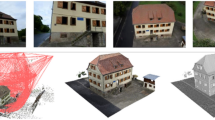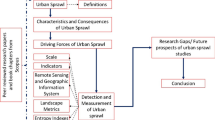Abstract
A feature relies on three dimensions (space, theme, and time) for its representation. Even though spatiotemporal models have been proposed, they have principally focused on the spatial changes of a feature. In this paper, a feature-based temporal model is proposed to represent the changes of both space and theme independently. The proposed model modifies the ISO’s temporal schema and adds new explicit temporal relationship structure that stores temporal topological relationship with the ISO’s temporal primitives of a feature in order to keep track feature history. The explicit temporal relationship can enhance query performance on feature history by removing topological comparison during query process. Further, a prototype system has been developed to test a proposed feature-based temporal model by querying land parcel history in Athens, Georgia. The result of temporal query on individual feature history shows the efficiency of the explicit temporal relationship structure.













Similar content being viewed by others
References
C. Armenakis. “Estimation and organization of spatio-temporal data”, in Proceedings of Canadian Conference on GIS92, Ottawa, Canada, pp. 900–911, 1992.
M.P. Armstrong. “Temporality in Spatial Databases,” in Proceedings of GIS/LIS ’88 (Volume 2), Bethesda, MD, 880–889, American Congress on Surveying and Mapping, 1988.
O. Balovnev, T. Bode, M. Breunig, A.B. Cremers, W. Muller, G. Pogodaev, S. Shumilov, J. Siebeck, A. Siehl, and A. Thomsen. “The story of the GeoToolKit-an object-oriented geodatabase kernel system,” GeoInformatica, Vol. 8(1):5–47, 2004.
B.J.L. Berry. “Approaches to regional analysis: A synthesis,” Annals of the Association of American Geographers, Vol. 54(2):2–11, 1964.
K.A.V. Borges, C.A. Davis Jr, and H.F. Laender. “OMT-G: An object-oriented data model for geographic applications,” GeoInformatica, Vol. 5(3):221–260, 2001.
B. Claramunt and M. Theriault. “Managing time in GIS: an event oriented approach,” in J. Clifford and A. Atuzhilin (Eds.), Recent Advances on Temporal Database, 23–42, 1995.( Berlin Heidelberg New York: Springer).
J.R. Davis. IBM’s DB2 spatial extender: Managing geo-spatial information within the DBMS, Technical reports, Research Division, IBM, Yew Youk, NY, 1998.
Environmental Systems Research Institute (ESRI). ESRI MapObjects™ Version 2.0, Redlands, CA, Environmental Systems Research Institute, 1999.
Environmental Systems Research Institute (ESRI). Modeling Our World, Redlands, CA, Environmental Systems Research Institute, 1999.
Environmental Systems Research Institute (ESRI). ArcGIS 9: Building a Geodatabase, Redlands, CA, Environmental Systems Research Institute, 2004.
A. Galton. “Fields and objects in space, time, and space-time,” Spatial Cognition and Computation, Vol. 4(1):39–68, 2004.
I. Graham. Object-oriented Methods: Principles and Practice. Pearson Education: London, 2001.
S.C. Guptill, K.J. Boyko, M.A. Domaratz, R.G. Fegeas, H.J. Rossmeissl, and E.L. Usery. An Enhanced Digital Line Graph Design, USGS Circular 1048, USGS: Restion, VA, 1990.
R.H. Güting, M.H. Böhlen, M. Erwig, C.S. Jensen, N.A. Lorentzos, M. Schneider, and M. Vazirgiannis. “A foundation for representing and querying moving objects,” ACM Transactions on Database Systems, Vol. 25(1):1–42, 2000.
International Standard Organization (ISO). Geographic information-Temporal schema, ISO/DIS 19108, WWW documents, http://www.ncits.org/ref-docs/ISO_DIS_19108.pdf (last accessed 27 August 2006), 2000.
G. Langran and N.R. Chrisman. “A framework for temporal geographic information,” Cartographica, Vol. 25(3):1–14, 1988.
C.P. Lo and A.K.W. Yeung. Concepts and Techniques of Geographic Information Systems. Prentice-Hall: NJ, 2002.
D.J.L. Marceau, L. Guindon, M. Bruel, and C. Marois, “Building temporal topology in a GIS database to study the land-use changes in a rural-urban environment,” Professional Geographer, Vol. 53(4):546–558, 2001.
Open Geospatial Consortium (OGC). Topic 1: feature geometry (ISO 19107 spatial schema) (Version 5), WWW documents, http://www.opengeospatial.org/standards/as (last accessed 27 August 2006), 2001.
Open Geospatial Consortium (OGC). Topic 5: features (Version 4), WWW documents, http://www.opengeospatial.org/standards/as (last accessed 27 August 2006), 1999.
Open Geospatial Consortium (OGC). Topic 8: Relationships between features (Version 4), WWW documents, http://www.opengeospatial.org/standards/as (last accessed 27 August 2006), 1999.
Open Geospatial Consortium (OGC). Topic 10: feature collections (Version 4), WWW documents, http://www.opengeospatial.org/standards/as (last accessed 27 August 2006), 1999.
Oracle Corporation. Oracle8: Database Administration: Vol. I, II, and III, Oracle Corporation: Redwood Shores, CA, 1998.
Oracle Corporation. Oracle8: Spatial Catridge, Oracle Corporation: Redwood Shores, CA, , 1997.
N. Pelekis, B. Theodoulidis, I. Kopanakis, and Y. Theodoridis. “Literature review of spatio-temporal database models,” Knowledge Engineering Review, Vol. 19(3):235–274, 2004.
D.J. Peuquet. “It’s about time: A conceptual framework for the representation of temporal dynamics in Geographic Information Systems,” Annals of the Association of American Geographers, Vol. 84–3:441–461, 1994.
D.J. Peuquet and N. Duan. “An event-based spatiotemporal data model (ESTDM) for temporal analysis of geographical data,” International Journal of Geographical Information Systems, Vol. 9(1):7–23, 1995.
J. Rumbaugh, M. Blaha, W. Premerlani, F. Eddy, and W. Lorensen. Object-Oriented Modelling and Design, Prentice-Hall: Englewood Cliffs, NJ, 1991.
R. Sengupta and C. Yan. “A hybrid spatio-temporal data model and structure (HST-DMS) for efficient storage and retrieval of land use information,” Transactions in GIS, Vol. 8(3):351–366, 2004.
E.L. Usery, G. Timson, and M. Coletti. “A Multidimensional geographic feature system,” in Proceedings of GIScience 2002: The Second International Conference on Geographic Information Science, National Atmospheric and Oceanic Administration (NAOA), pp. 279–282, 2002.
U.S. Geological Survey. Spatial Data Transfer Standard (SDTS)-Part 1, Logical Specifications. American National Standards Institute: New York, 1997.
M.F. Worboys. “A model for spatio-temporal information,” In Proceeding of the Fifth International Symposium on Spatial Data Handling (Volume 2), in P. Bresnahan, E. Corwin, and D. Cowen. American Congress on Surveying and Mapping: San Jose, CA, pp. 602–611, 1992.
M.F. Worboys. “Object-oriented approaches to geo-referenced information,” International Journal of Geographic Information Systems, Vol. 8(4):385–399, 1994.
M.F. Worboys. “A unified model for spatial and temporal information,” The Computer Journal, Vol. 37(1):26–34, 1994.
M.F. Worboys. “Modelling changes and events in dynamic spatial systems with reference to socio-economic units,” in A.U. Frank, J. Raper, and J.P. Cheylan (Eds.), Life and Motion of Socio-Economic Units, pp. 129–138, Taylor and Francis, 2001.
M. Yuan. “Wildfire conceptual modeling for building GIS space-time models,” in Proceedings of GIS/LIS’94, Phoenix, Arizona, pp. 860–869, 1994.
M. Yuan. “Modeling semantical, temporal, and spatial information in geographic information systems,” in M. Craglia and H. Couclelis (Eds.), Geographic Information Research: Bridging the Atlantic, pp. 334–347, Taylor and Francis, 1996.
M. Yuan. “Use of a three-domain representation to enhance GIS support for complex spatiotemporal queries,” Transactions in GIS, Vol. 3(2):137–159, 1999.
Author information
Authors and Affiliations
Corresponding author
Rights and permissions
About this article
Cite this article
Choi, J., Seong, J.C., Kim, B. et al. Innovations in Individual Feature History Management—The Significance of Feature-based Temporal Model. Geoinformatica 12, 1–20 (2008). https://doi.org/10.1007/s10707-007-0019-y
Received:
Revised:
Accepted:
Published:
Issue Date:
DOI: https://doi.org/10.1007/s10707-007-0019-y




